Climatic Effects of Spring Mesoscale Oceanic Eddies in the North Pacific: A Regional Modeling Study
Abstract
1. Introduction
2. Data and Methods
2.1. Observational Data
2.2. Model and Experimental Design
2.2.1. Model Description
2.2.2. Experimental Design
2.2.3. Empirical Monte Carlo Significance Test
3. Results
3.1. Model Validation
3.2. Impacts of OEs in the Whole NPac
3.3. Impacts of OEs in the Northern and Southern NPac
3.3.1. Atmospheric Circulations
3.3.2. Storm Track
3.4. Sub-Seasonal Varitions
4. Conclusions and Discussion
Author Contributions
Funding
Data Availability Statement
Acknowledgments
Conflicts of Interest
References
- Kushnir, Y.; Robinson, W.A.; Blade, I.; Hall, N.M.J.; Peng, S.; Sutton, R. Atmospheric GCM response to extratropical SST anomalies: Synthesis and Evaluation. J. Clim. 2002, 15, 2233–2256. [Google Scholar] [CrossRef]
- Wentz, F.J.; Schabel, M.C. Precise climate monitoring using complementary satellite data sets. Nature 2000, 403, 414–416. [Google Scholar] [CrossRef] [PubMed]
- Chelton, D.B.; Schlax, M.G.; Freilich, M.H.; Milliff, R.F. Satellite measurements reveal persistent small-scale features in ocean winds. Science 2004, 303, 978–983. [Google Scholar] [CrossRef] [PubMed]
- Xie, S.P. Satellite observations of cool ocean-atmosphere interaction. Bull. Am. Meteorol. Soc. 2004, 85, 195–208. [Google Scholar] [CrossRef]
- Chelton, D.B.; Wentz, F.J. Global microwave satellite observations of sea surface temperature for numerical weather prediction and climate research. Bull. Am. Meteorol. Soc. 2005, 86, 1097–1115. [Google Scholar] [CrossRef]
- Chelton, D.B.; Xie, S.P. Coupled ocean-atmosphere interaction at oceanic mesoscale. Oceanography 2010, 23, 52–69. [Google Scholar] [CrossRef]
- Byrne, D.; Papritz, L.; Frenger, I.; Munnich, M.; Gruber, N. Atmospheric response to mesoscale sea surface temperature anomalies: Assessment of mechanisms and coupling strength in a high-resolution coupled model over the South Atlantic. J. Atmos. Sci. 2015, 72, 1872–1890. [Google Scholar] [CrossRef]
- Minobe, S.; Kuwano-Yoshida, A.; Komori, N.; Xie, S.P.; Small, R.J. Influence of the Gulf Stream on the troposphere. Nature 2008, 452, 206–209. [Google Scholar] [CrossRef] [PubMed]
- Small, R.J.; Deszoeke, S.P.; Xie, S.P.; O’Neull, L.; Seo, H.; Song, Q.; Cornillon, P.; Spall, M.; Minobe, S. Air-sea interaction over ocean fronts and eddies. Dyn. Atmos. Ocean. 2008, 45, 274–319. [Google Scholar] [CrossRef]
- Iizuka, S. Simulations of wintertime precipitation in the vicinity of Japan: Sensitivity to fine-scale distributions of sea surface temperature. J. Geophys. Res. Atmos. 2010, 115. [Google Scholar] [CrossRef]
- Kuwano-Yoshida, A.; Minobe, S.; Xie, S.P. Precipitation response to the Gulf Stream in an atmospheric GCM. J. Clim. 2010, 23, 3676–3698. [Google Scholar] [CrossRef]
- O’neill, L.W.; Chelton, D.B.; Esbensen, S.K. Covariability of surface wind and stress responses to sea surface temperature fronts. J. Clim. 2012, 25, 5916–5942. [Google Scholar] [CrossRef]
- Saravanan, R.; Chang, P. Midlatitude mesoscale ocean-atmosphere interaction and its relevance to S2S prediction. In Sub-Seasonal to Seasonal Prediction; Elsevier: Amsterdam, The Netherlands, 2019; pp. 183–200. [Google Scholar] [CrossRef]
- Nakamura, H.; Sampe, T.; Tanimoto, Y.; Shimpo, A. Observed associations among storm tracks, jet streams and midlatitude oceanic fronts. In Earth’s Climate: The Ocean-Atmosphere Interaction; Geophysical Monograph Series; American Geophysical Union: Washington, DC, USA, 2004; Volume 147, pp. 329–345. [Google Scholar] [CrossRef]
- Taguchi, B.; Nakamura, H.; Nonaka, M.; Xie, S.P. Influences of the Kuroshio/Oyashio Extensions on air-sea heat exchanges and storm-track activity as revealed in regional atmospheric model simulations for the 2003/04 cold season. J. Clim. 2009, 22, 6536–6560. [Google Scholar] [CrossRef]
- Small, R.J.; Tomas, R.A.; Bryan, F.O. Storm track response to ocean fronts in a global high-resolution climate model. Clim. Dyn. 2014, 43, 805–828. [Google Scholar] [CrossRef]
- Piazza, M.; Terray, L.; Boe, J.; Maisonnave, E.; Sanchez-Gomez, E. Influence of small-scale North Atlantic sea surface temperature patterns on the marine boundary layer and free troposphere: A study using the atmospheric ARPEGE model. Clim. Dyn. 2016, 46, 1699–1717. [Google Scholar] [CrossRef]
- Bourras, D.; Reverdin, G.; Giordani, H.; Caniaux, G. Response of the atmospheric boundary layer to a mesoscale oceanic eddy in the northeast Atlantic. J. Geophys. Res. Atmos. 2004, 109, 1–19. [Google Scholar] [CrossRef]
- Chou, C.H.; Liu, Q. Eddy effects on sea surface temperature and sea surface wind in the continental slope region of the northern South China Sea. Geophys. Res. Lett. 2012, 39, L02601. [Google Scholar] [CrossRef]
- Lambaerts, J.; Lapeyre, G.; Plougonven, R.; Klen, P. Atmospheric response to sea surface temperature mesoscale structures. J. Geophys. Res. Atmos. 2013, 118, 9611–9621. [Google Scholar] [CrossRef]
- Li, W.B.; Liu, H.Y.; Fang, R. Review of the atmospheric response to the ocean mesoscale eddies. Adv. Earth Sci. 2017, 32, 1039–1049. [Google Scholar] [CrossRef]
- Frenger, I.; Gruber, N.; Knutti, R.; Munnich, M. Imprint of southern ocean eddies on winds, clouds and rainfall. Nat. Geosci. 2013, 6, 608–612. [Google Scholar] [CrossRef]
- Rouault, M.; Verley, P.; Backeberg, B. Wind increase above warm Agulhas Current eddies. Ocean Sci. Discuss. 2014, 11, 2367–2389. [Google Scholar] [CrossRef]
- Gaube, P.; Chelton, D.B.; Samelson, R.M.; Schlax, M.G.; O’Neill, L.W. Satellite observations of mesoscale eddy-induced ekman pumping. J. Phys. Oceanogr 2015, 45, 104–132. [Google Scholar] [CrossRef]
- Shan, H.; Dong, C. Atmospheric responses to oceanic mesoscale eddies based on an idealized model. Int. J. Climatol. 2019, 39, 1665–1683. [Google Scholar] [CrossRef]
- Ma, J.; Xu, H.; Dong, C.; Lin, P.; Liu, Y. Atmospheric responses to oceanic eddies in the Kuroshio Extension region. J. Geophys. Res. Atmos. 2015, 120, 6313–6330. [Google Scholar] [CrossRef]
- Ma, J.; Xu, H.; Dong, C. Seasonal variations in atmospheric responses to oceanic eddies in the Kuroshio Extension. Tellus A Dyn. Meteorol. Oceanogr. 2016, 68, 31563. [Google Scholar] [CrossRef]
- Perlin, N.; De Szoeke, S.P.; Chelton, D.B.; Samelson, R.M.; Skyllingstad, E.D.; O’Neill, L.W. Modeling the atmospheric boundary layer wind response layer wind response to mesoscale sea surface temperature perturbations. Mon. Weather Rev. 2014, 142, 4284–4307. [Google Scholar] [CrossRef]
- Ma, X.; Chang, P.; Saravanan, R.; Montuoro, R.; Hsieh, J.; Wu, D.; Lin, X.; Wu, L.; Jing, Z. Distant influence of Kuroshio eddies on North Pacific weather patterns. Sci. Rep. 2015, 5, 17785. [Google Scholar] [CrossRef]
- Ma, X.; Chang, P.; Saravanan, R.; Monturo, R.; Nakamura, H.; Wu, D.; Lin, X.; Wu, L. Importance of resolving Kuroshio front and eddy influence in simulating the North Pacific storm track. J. Clim. 2017, 30, 1861–1880. [Google Scholar] [CrossRef]
- Foussard, A.; Lapeyre, G.; Plougonven, R. Storm track response to oceanic eddies in idealized atmospheric simulations. J. Clim. 2019, 32, 445–463. [Google Scholar] [CrossRef]
- Liu, Y.; Dong, C.; Guan, Y.; Chen, D.; McWilliams, J.; Nencioli, F. Eddy analysis in the subtropical zonal band of the North Pacific Ocean. Deep Sea Res. Part I Oceanogr. Res. Pap. 2012, 68, 54–67. [Google Scholar] [CrossRef]
- Ji, J.; Dong, C.; Zhang, B.; Liu, Y.; Zou, B.; King, G.P.; Xu, G.; Chen, D. Oceanic eddy characteristics and generation mechanisms in the Kuroshio Extension region. J. Geophys. Res. Ocean. 2018, 123, 8548–8567. [Google Scholar] [CrossRef]
- Ji, J.; Ma, J.; Dong, C.; Chiang, J.C.H.; Chen, D. Regional dependence of atmospheric responses to oceanic eddies in the North Pacific ocean. Remote Sens. 2020, 12, 1161. [Google Scholar] [CrossRef]
- Putrasahan, D.A.; Miller, A.J.; Seo, H. Isolating mesoscale coupled ocean–atmosphere interactions in the kuroshio extension region. Dyn. Atmos. Ocean. 2013, 63, 60–78. [Google Scholar] [CrossRef]
- Seo, H.; Miller, A.J.; Norris, J.R. Eddy–wind interaction in the California Current System: Dynamics and impacts. J. Phys. Oceanogr. 2016, 46, 439–459. [Google Scholar] [CrossRef]
- Jia, Y.; Chang, P.; Szunyogh, I.; Saravanan, R.; Bacmeister, J.T. A modeling strategy for the investigation of the effect of mesoscale SST variability on atmospheric dynamics. Geophys. Res. Lett. 2019, 46, 3982–3989. [Google Scholar] [CrossRef]
- Kobashi, F.; Kawamura, H. Seasonal variation and instability nature of the North Pacific Subtropical Countercurrent and the Hawaiian Lee Countercurrent. J. Geophys. Res. Ocean. 2002, 107, 6-1–6-18. [Google Scholar] [CrossRef]
- Qiu, B.; Chen, S. Interannual variability of the North Pacific subtropical countercurrent and its associated mesoscale eddy field. J. Phys. Oceanogr. 2010, 40, 215–225. [Google Scholar] [CrossRef]
- Reynolds, R.W.; Smith, T.M.; Liu, C.; Chelton, D.B.; Casey, K.S.; Schlax, M.G. Daily high-resolution-blended analyses for sea surface temperature. J. Clim. 2007, 20, 5473–5496. [Google Scholar] [CrossRef]
- Liu, T.W.; Xie, X.; Polito, P.S.; Xie, S.P.; Hashizume, H. Atmospheric manifestation of tropical instability wave observed by QuikSCAT and tropical rain measuring mission. Geophys. Res. Lett. 2000, 27, 2545–2548. [Google Scholar] [CrossRef]
- Saha, S.; Moorthi, S.; Pan, H.L.; Wu, X.; Wang, J.; Nadiga, S.; Tripp, P.; Kistler, R.; Woollen, J.; Behringer, D. The NCEP climate forecast system reanalysis. Bull. Am. Meteorol. Soc. 2010, 91, 1015–1058. [Google Scholar] [CrossRef]
- Liu, J.W.; Zhang, S.P.; Xie, S.P. Two types of surface wind responses to the East China Sea Kuroshio front. J. Clim. 2013, 26, 8616–8627. [Google Scholar] [CrossRef]
- Chelton, D.B.; Schlax, M.G.; Samelson, R.M. Global observations of nonlinear mesoscale eddies. Prog. Oceanogr. 2011, 91, 167–216. [Google Scholar] [CrossRef]
- Williams, S.; Petersen, M.; Bremer, P.T.; Hecht, M.; Pascucci, V.; Ahrens, J.; Hlawitschka, M.; Hamann, B. Adaptive extraction and quantification of geophysical vortices. IEEE Trans. Vis. Comput. Graph. 2011, 17, 2088–2095. [Google Scholar] [CrossRef] [PubMed]
- Willison, J.; Robinson, W.A.; Lackmann, G.M. The importance of resolving mesoscale latent heating in the North Atlantic storm track. J. Atmos. Sci. 2013, 70, 2234–2250. [Google Scholar] [CrossRef]
- Pujol, M.I.; Faugere, Y.; Taburet, G.; Dupuy, S.; Pelloquin, C.; Ablain, M.; Picot, N. DUACS DT2014: The new multi-mission altimeter dataset reprocessed over 20 years. Ocean Sci. Discuss. 2016, 12, 1067–1090. [Google Scholar] [CrossRef]
- Skamarock, W.C.; Klemp, J.B.; Dudhia, J.; Gill, D.O.; Barker, D.M.; Duda, M.G.; Huang, X.; Wang, W.; Powers, J.G. A Description of the Advanced Research WRF Version 3; NCAR Tech. Note/TN-475+ STR; University Corporation for Atmospheric Research: Boulder, CO, USA, 2008. [Google Scholar]
- O’neill, L.W.; Esbensen, S.K.; Thum, N.; Samelson, R.M.; Chelton, D.B. Dynamical analysis of the boundary layer and surface wind responses to mesoscale SST perturbations. J. Clim. 2010, 23, 559–581. [Google Scholar] [CrossRef]
- Zhou, G.; Latif, M.; Greatbatch, R.J.; Park, W. Atmosphereric response to the North Pacific enabled by daily sea surface temperature variability. Geophys. Res. Lett. 2015, 42, 7732–7739. [Google Scholar] [CrossRef]
- Dong, C.; Nencioli, F.; Liu, Y.; McWilliams, J.C. An automated approach to detect oceanic eddies from satellite remotely sensed sea surface temperature data. IEEE Geosci. Remote Sens. Lett. 2011, 8, 1055–1059. [Google Scholar] [CrossRef]
- Greene, C.A.; Thirumalai, K.; Kearney, K.A.; Delgado, J.M.; Schwanghart, W.; Wolfenbarger, N.S.; Thyng, K.M.; Gwyther, D.E.; Gardner, A.S.; Blankenship, D.D. The climate data toolbox for MATLAB. Geochem. Geophys. Geosyst. 2019, 20, 3774–3781. [Google Scholar] [CrossRef]
- Yao, Y.; Zhong, Z.; Yang, X. Numerical experiments of the storm track sensitivity to oceanic frontal strength within the Kuroshio/Oyashio Extensions. J. Geophys. Res. Atmos. 2016, 121, 2888–2900. [Google Scholar] [CrossRef]
- Huang, J.; Zhang, Y.; Yang, X.; Ren, X.; Hu, H. Impacts of North Pacific subtropical and subarctic oceanic frontal zones on the wintertime atmospheric large-scale circulations. J. Clim. 2020, 33, 1897–1914. [Google Scholar] [CrossRef]
- O’neill, L.W.; Chelton, D.B.; Esbensen, S.K. Observations of SST-induced perturbations of the wind stress field over the Southern Ocean on seasonal time scales. J. Clim. 2003, 16, 2340–2354. [Google Scholar] [CrossRef]
- Chelton, D.B.; Schlax, M.G.; Samelson, R.M. Summertime coupling between sea surface temperature and wind stress in the California Current System. J. Phys. Oceanogr. 2007, 37, 495–517. [Google Scholar] [CrossRef]
- Seo, H.; Murtugudde, R.; Jochum, M.; Mller, A.J. Modeling of mesoscale coupled ocean-atmosphere interaction and its feedback to ocean in the western Arabian Sea. Ocean Model. 2008, 25, 120–131. [Google Scholar] [CrossRef]
- Bryan, F.O.; Tomas, R.A.; Dennis, J.M.; Dudley, B.C. Frontal scale air–sea interaction in high-resolution coupled climate models. J. Clim. 2010, 23, 6277–6291. [Google Scholar] [CrossRef]
- Zhang, R.H. Effects of tropical instability wave (TIW)-induced surface wind feedback in the tropical Pacific Ocean. Clim. Dyn. 2014, 42, 467–485. [Google Scholar] [CrossRef]
- Gao, J.; Zhang, R.H.; Wang, H. Mesoscale SST perturbation-induced impacts on climatological precipitation in the Kuroshio-Oyashio extension region, as revealed by the WRF simulations. J. Oceanol. Limnol. 2019, 37, 385–397. [Google Scholar] [CrossRef]
- Song, Q.; Chelton, D.B.; Esbensen, S.K.; Thum, N.; O’Neill, L.W. Coupling between sea surface temperature and low-level winds in mesoscale numerical models. J. Clim. 2009, 22, 146–164. [Google Scholar] [CrossRef]
- Booth, J.F.; Thompson, L.A.; Patoux, J.; Kathryn, A.K.; Dickinson, S. The signature of the midlatitude tropospheric storm tracks in the surface winds. J. Clim. 2010, 23, 1160–1174. [Google Scholar] [CrossRef]
- Deremble, B.; Lapeyre, G.; Ghil, M. Atmospheric dynamics triggered by an oceanic SST front in a mosit quasigeostrophic model. J. Atmos. Sci. 2012, 69, 1617–1632. [Google Scholar] [CrossRef]
- Thomson, S.I.; Vallis, G.K. Atmospheric response to SST anomalies. Part I: Background-state dependence, teleconnections, and local effects in winter. J. Atmos. Sci. 2018, 75, 4107–4124. [Google Scholar] [CrossRef]
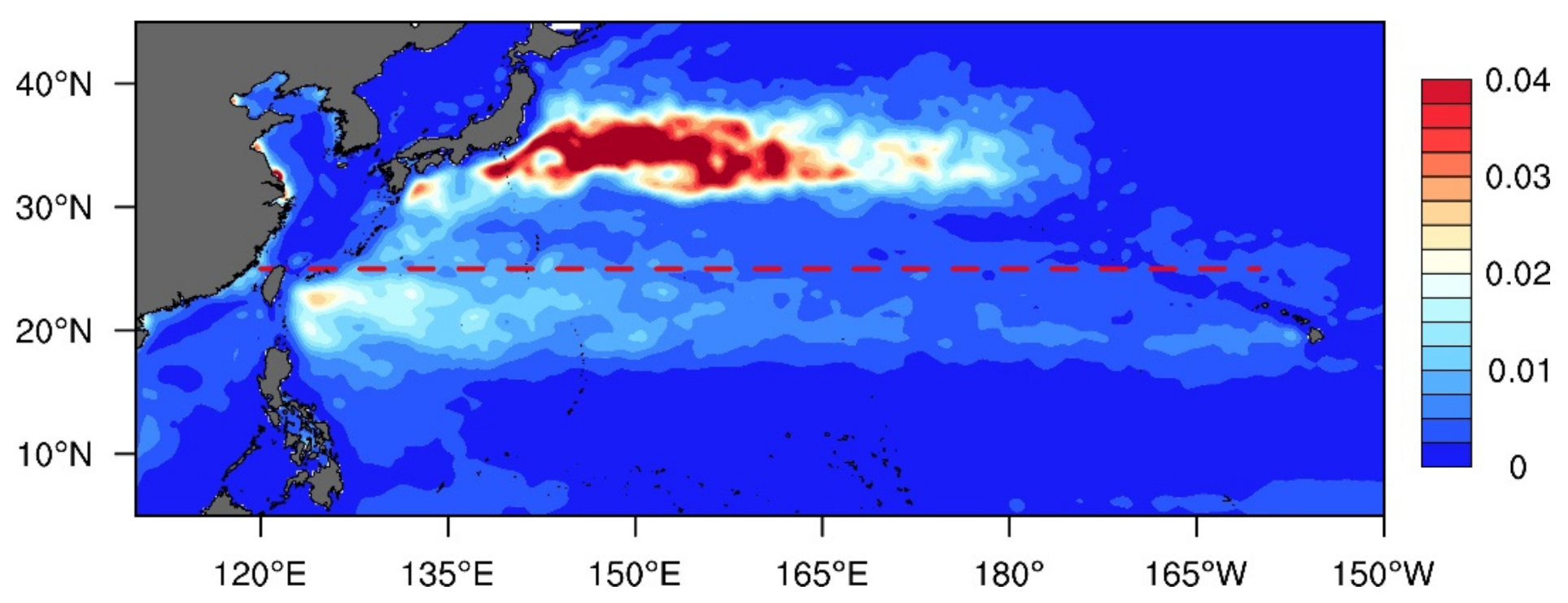
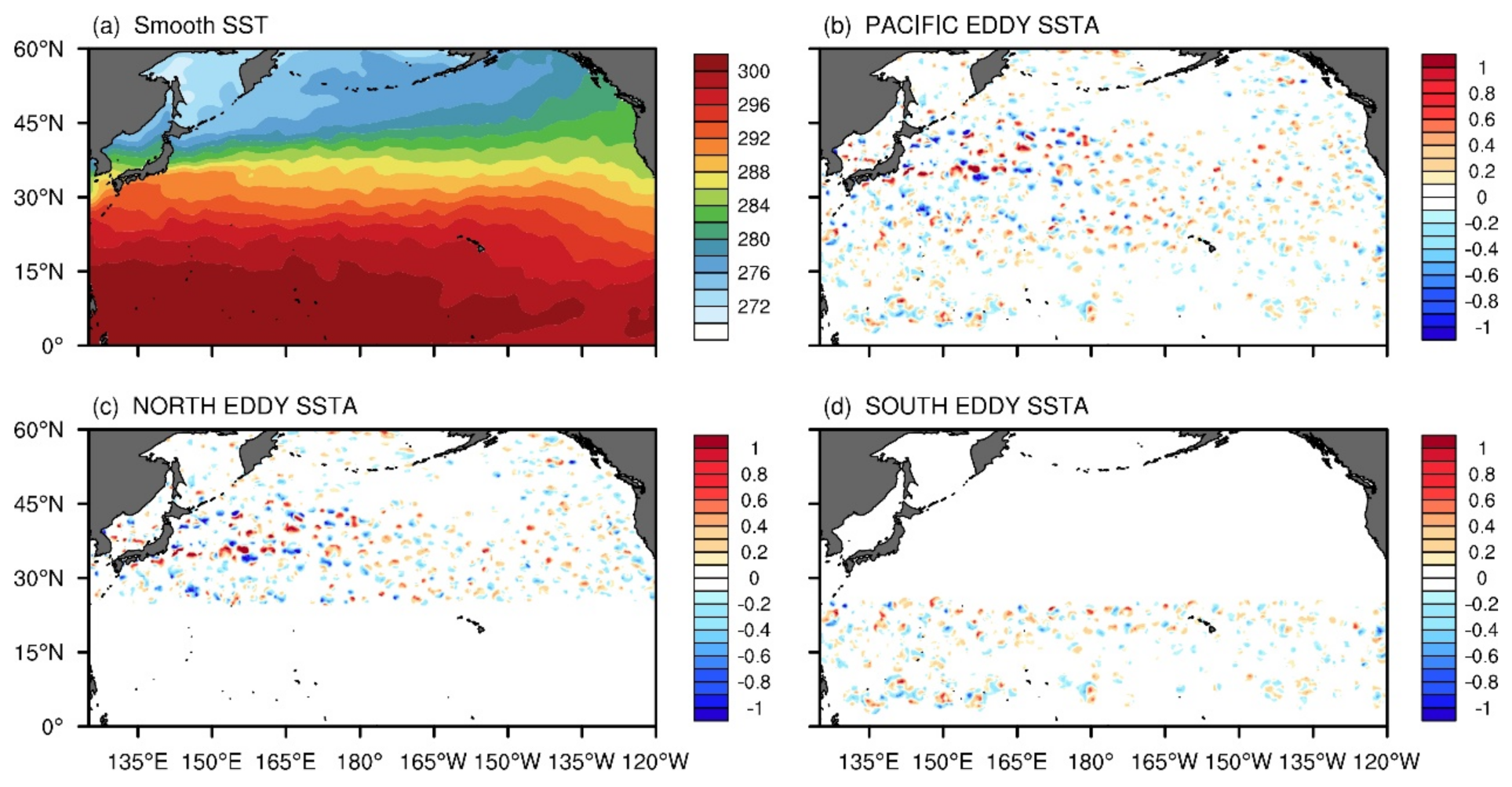
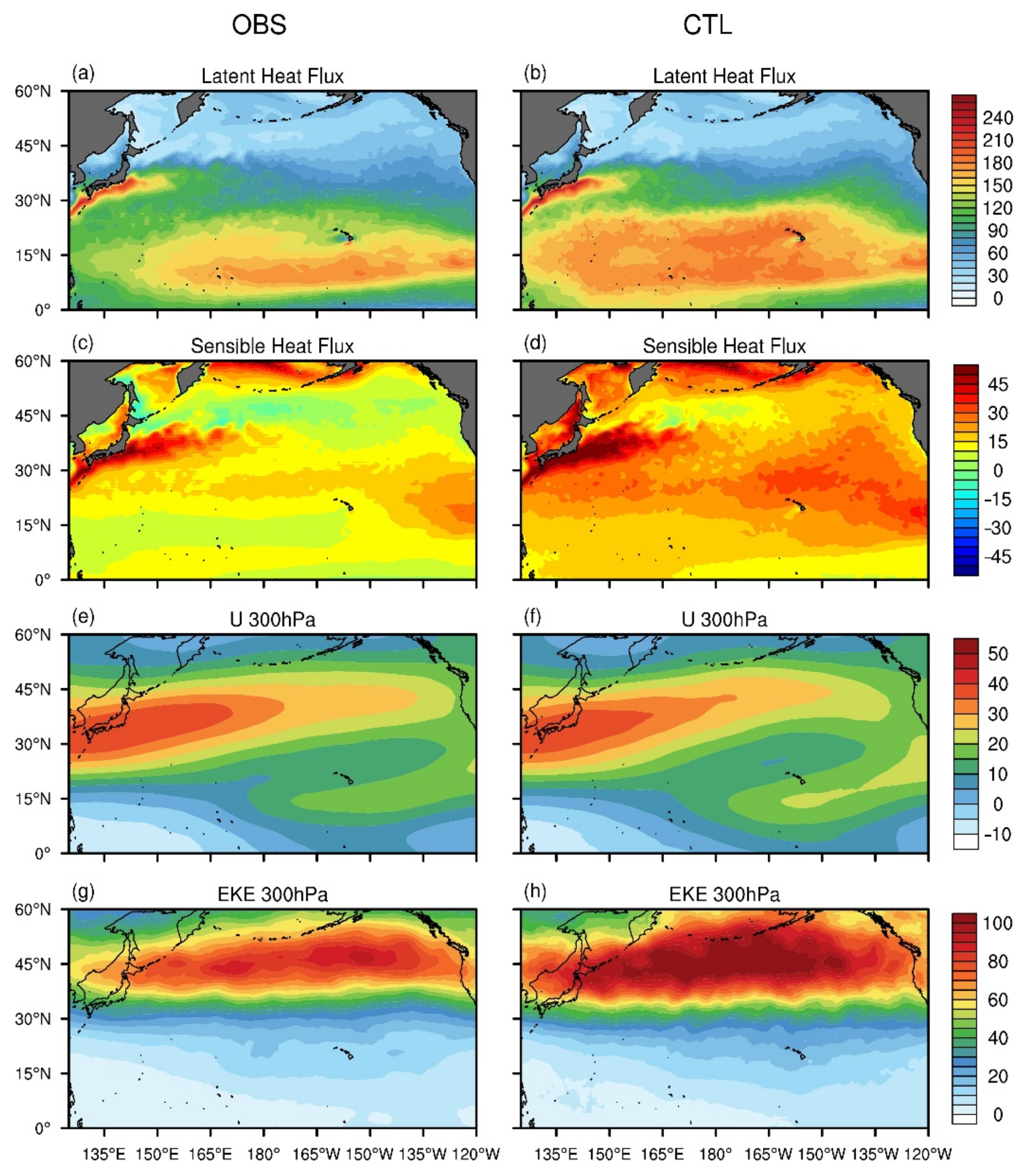
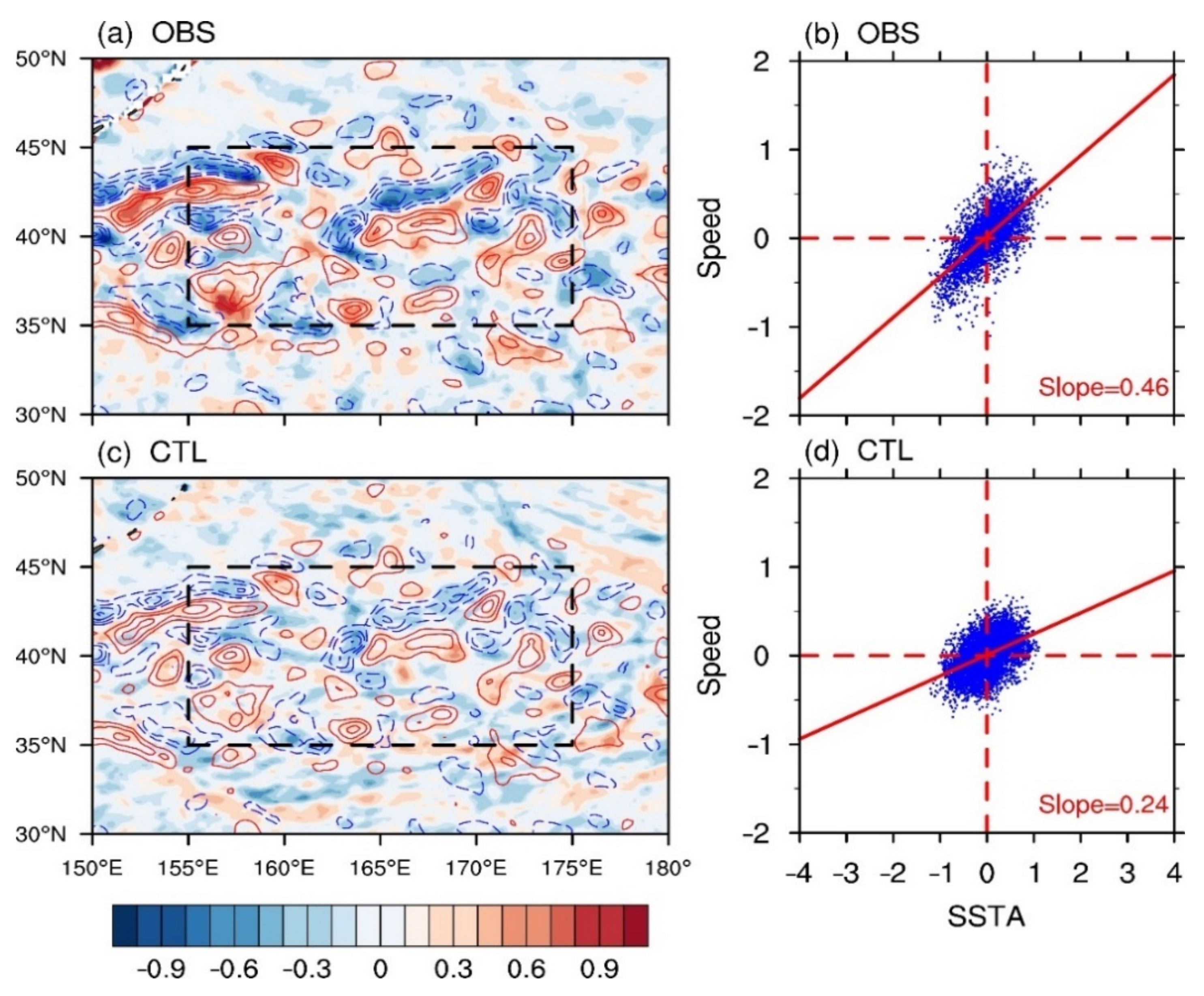
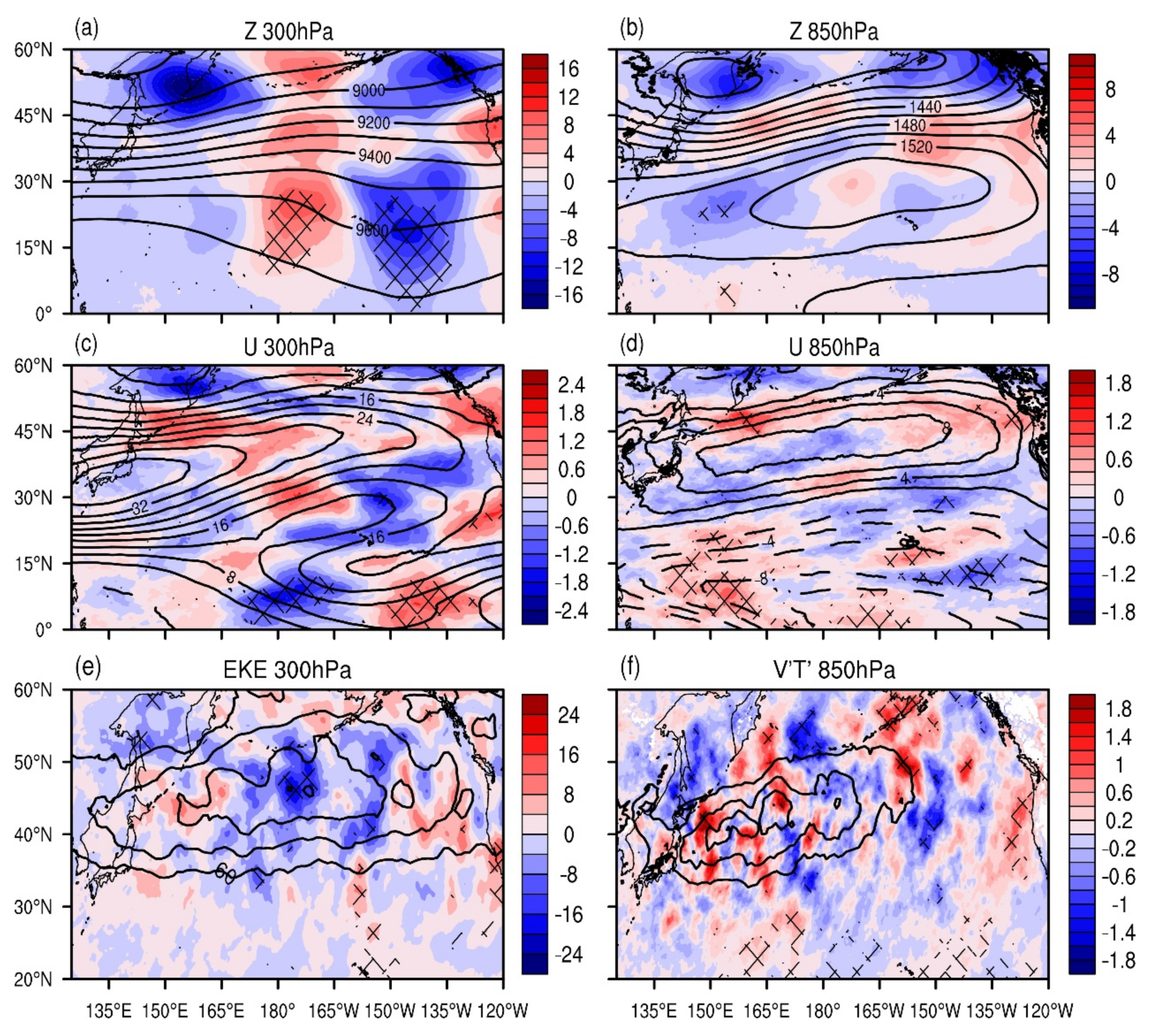
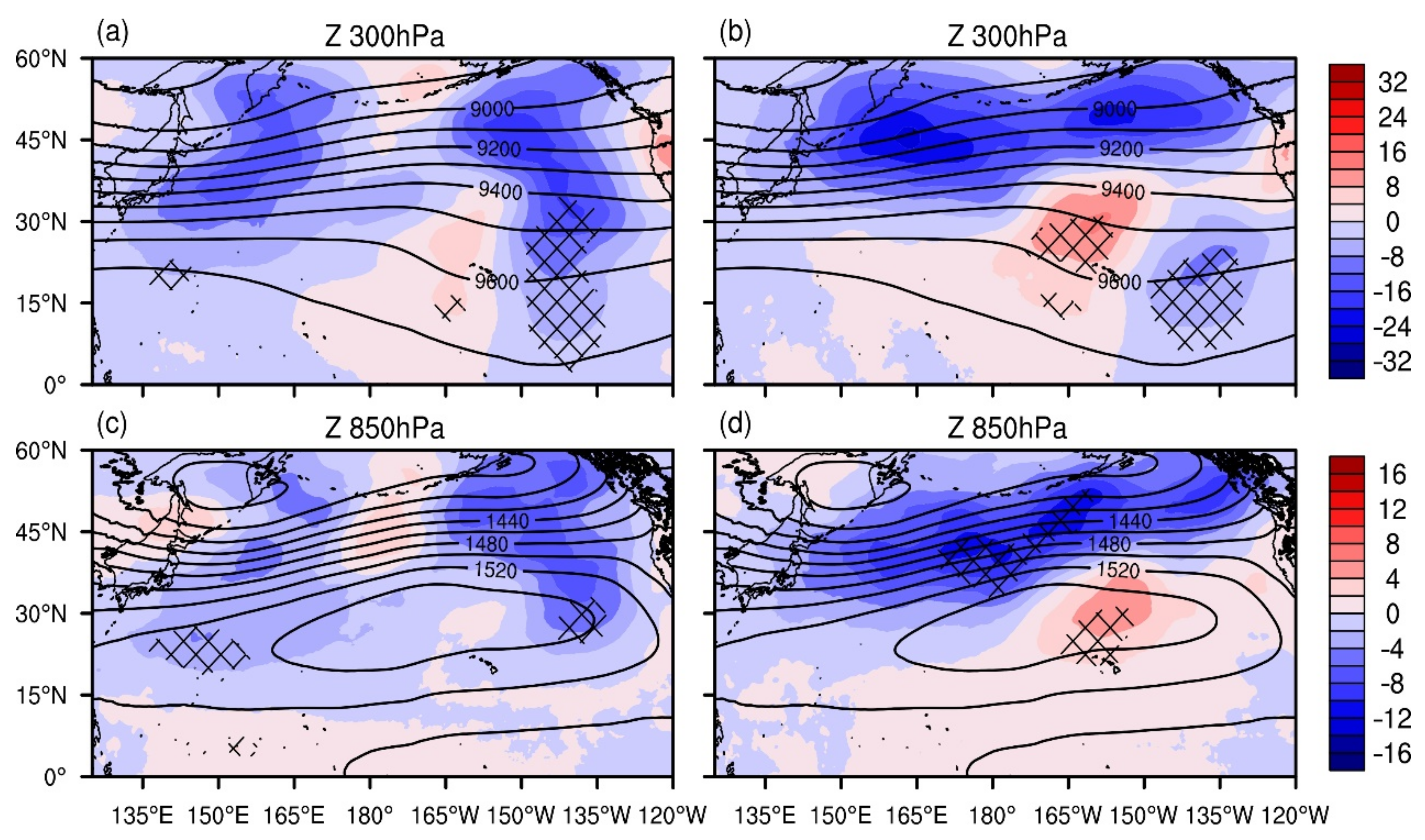
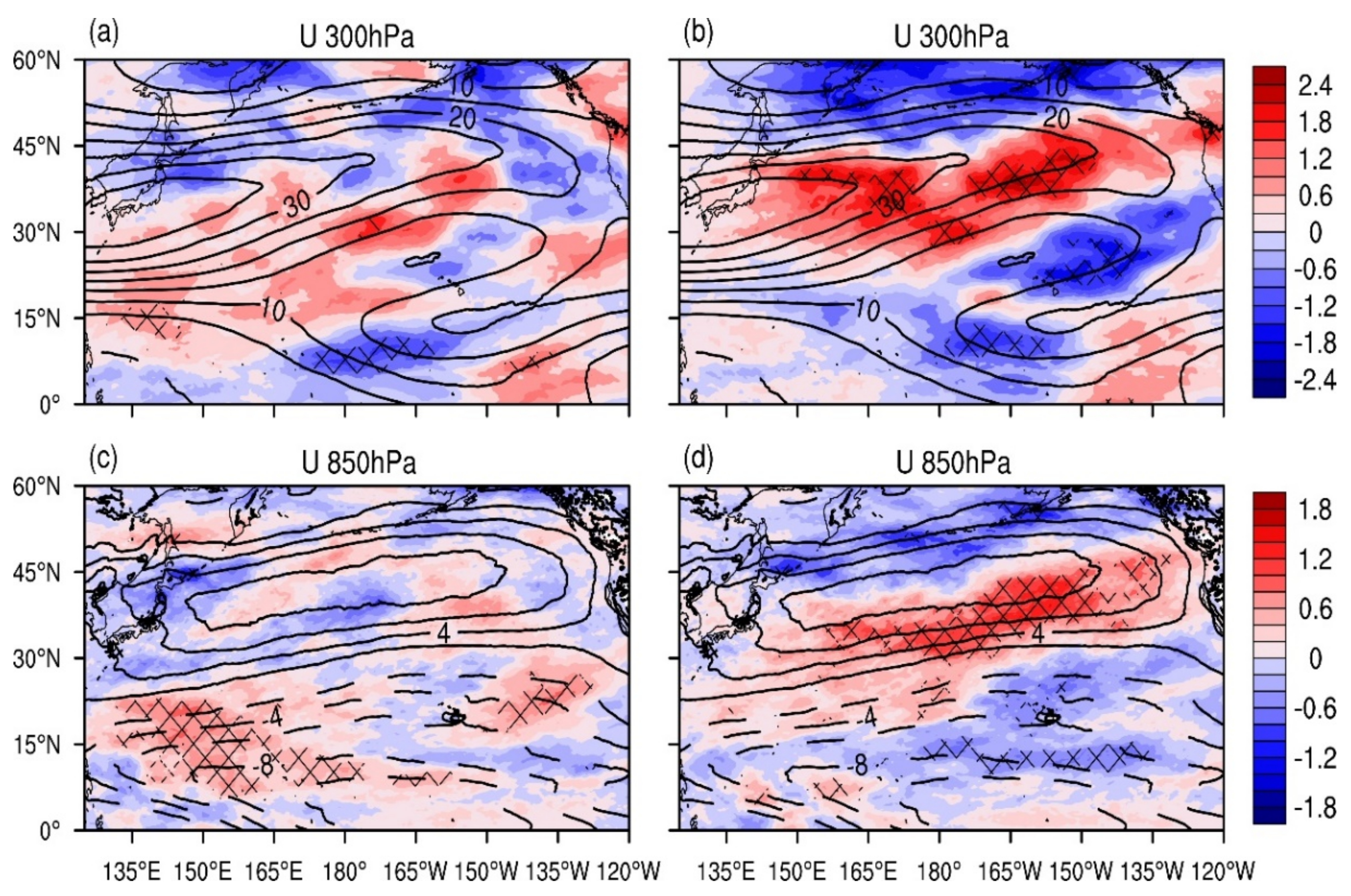
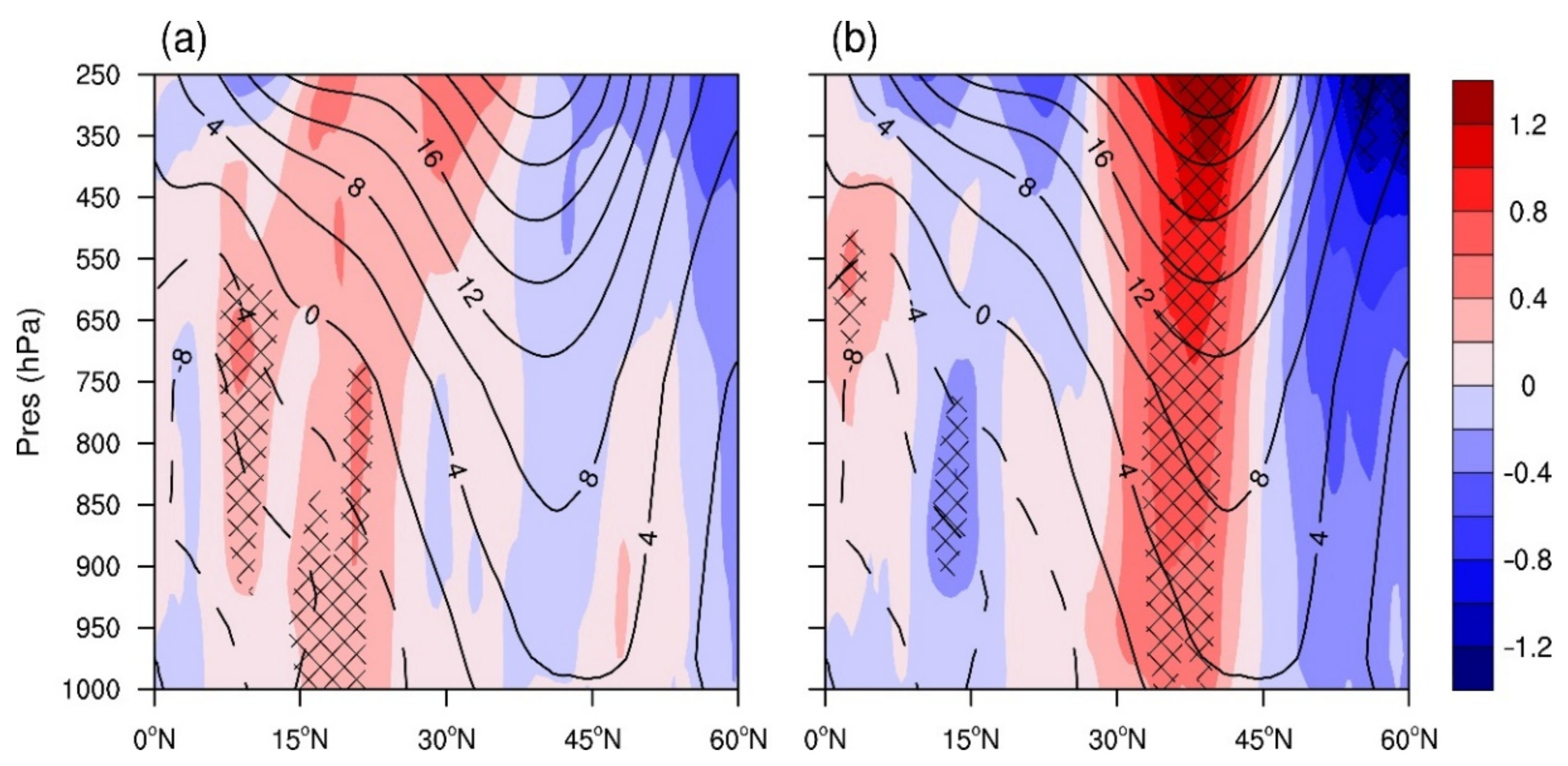
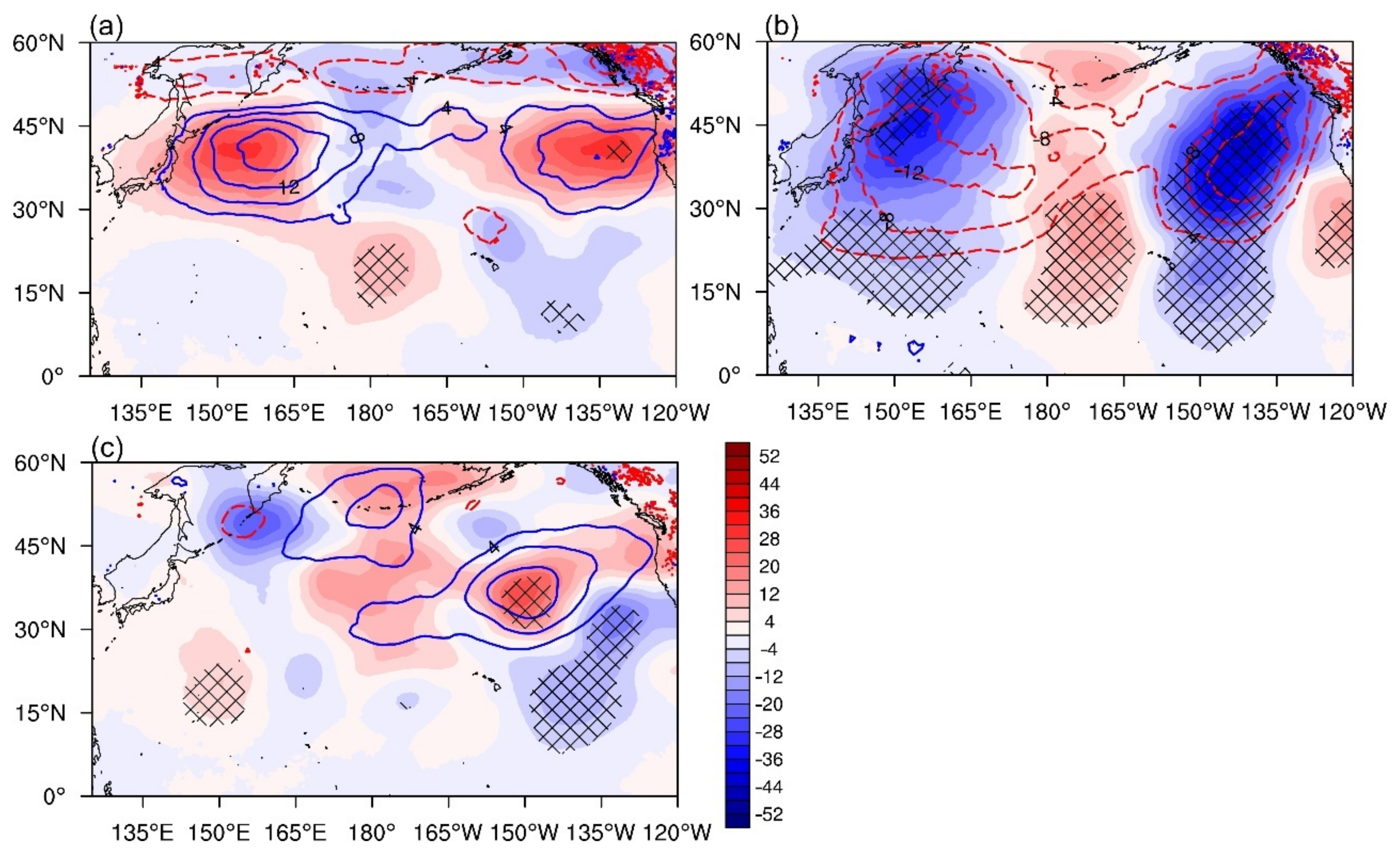
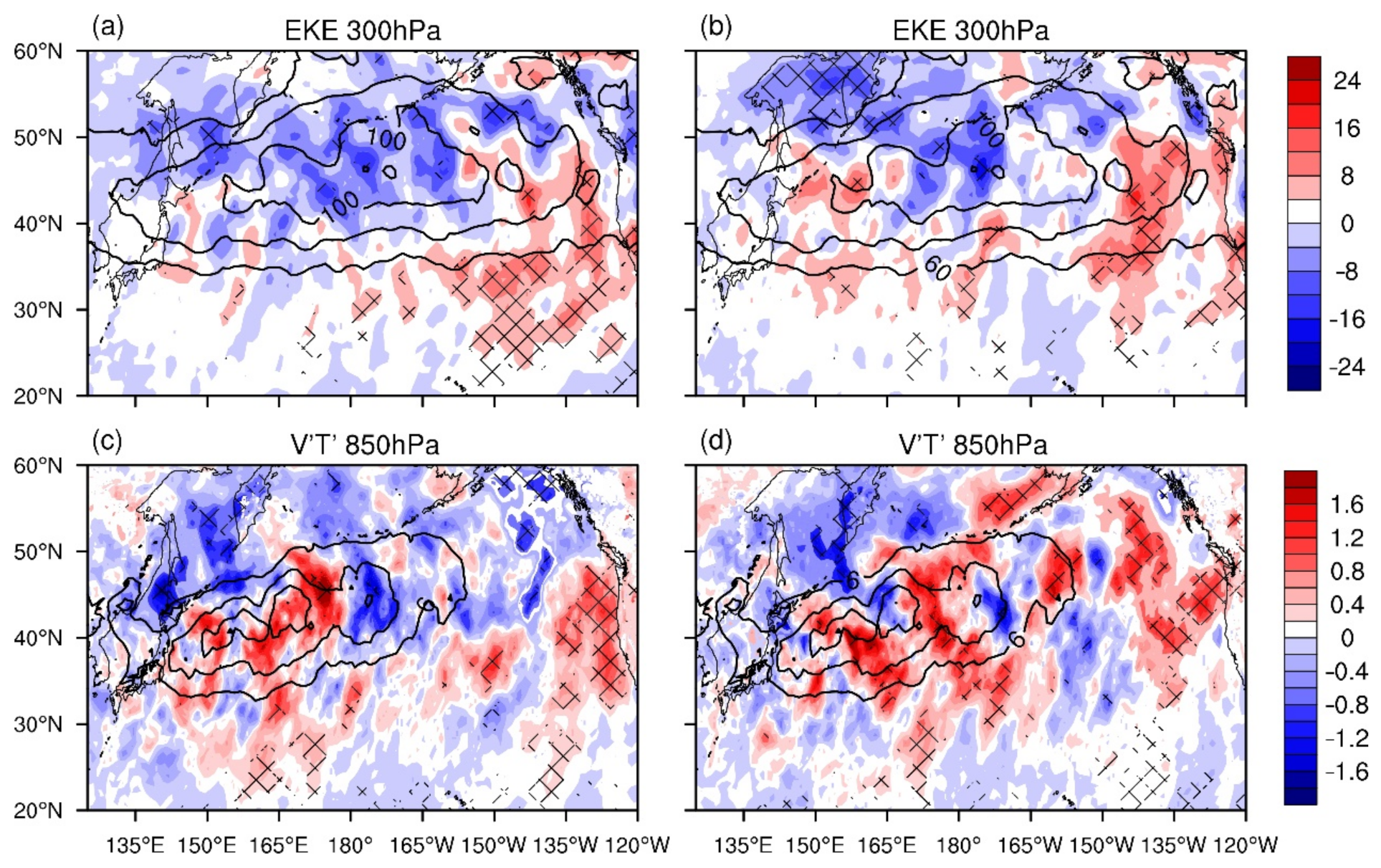


| Experiment | Description of Experiments |
|---|---|
| Control experiment (CTL) | Observed daily sea surface temperature (SST) is used as the boundary condition of the model |
| Smoothed-SST experiment (SmthSST) | Same as CTL, but with the spatially smoothed SST used as the boundary condition of the model |
| EddySSTA | Same as SmthSST, but with sea surface temperature anomalies (SSTAs) associated with the oceanic eddies in the whole north Pacific (NPac) being superimposed on the smoothed SST |
| EddySSTA + N25N | Same as EddySSTA, but with SSTAs associated with the oceanic eddies to the north of 25° N being superimposed on the smoothed SST |
| EddySSTA + S25N | Same as EddySSTA, but with SSTAs associated with the oceanic eddies to the south of 25° N being superimposed on the smoothed SST |
Publisher’s Note: MDPI stays neutral with regard to jurisdictional claims in published maps and institutional affiliations. |
© 2021 by the authors. Licensee MDPI, Basel, Switzerland. This article is an open access article distributed under the terms and conditions of the Creative Commons Attribution (CC BY) license (https://creativecommons.org/licenses/by/4.0/).
Share and Cite
Cai, Z.; Xu, H.; Ma, J.; Deng, J. Climatic Effects of Spring Mesoscale Oceanic Eddies in the North Pacific: A Regional Modeling Study. Atmosphere 2021, 12, 517. https://doi.org/10.3390/atmos12040517
Cai Z, Xu H, Ma J, Deng J. Climatic Effects of Spring Mesoscale Oceanic Eddies in the North Pacific: A Regional Modeling Study. Atmosphere. 2021; 12(4):517. https://doi.org/10.3390/atmos12040517
Chicago/Turabian StyleCai, Zhiying, Haiming Xu, Jing Ma, and Jiechun Deng. 2021. "Climatic Effects of Spring Mesoscale Oceanic Eddies in the North Pacific: A Regional Modeling Study" Atmosphere 12, no. 4: 517. https://doi.org/10.3390/atmos12040517
APA StyleCai, Z., Xu, H., Ma, J., & Deng, J. (2021). Climatic Effects of Spring Mesoscale Oceanic Eddies in the North Pacific: A Regional Modeling Study. Atmosphere, 12(4), 517. https://doi.org/10.3390/atmos12040517






